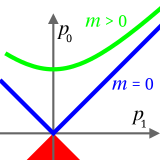 Global Information
Global InformationInvariant mass information
This article has multiple issues. Please help improve it or discuss these issues on the talk page. (Learn how and when to remove these template messages)
|
The invariant mass, rest mass, intrinsic mass, proper mass, or in the case of bound systems simply mass, is the portion of the total mass of an object or system of objects that is independent of the overall motion of the system. More precisely, it is a characteristic of the system's total energy and momentum that is the same in all frames of reference related by Lorentz transformations.[1] If a center-of-momentum frame exists for the system, then the invariant mass of a system is equal to its total mass in that "rest frame". In other reference frames, where the system's momentum is nonzero, the total mass (a.k.a. relativistic mass) of the system is greater than the invariant mass, but the invariant mass remains unchanged.
Because of mass–energy equivalence, the rest energy of the system is simply the invariant mass times the speed of light squared. Similarly, the total energy of the system is its total (relativistic) mass times the speed of light squared.
Systems whose four-momentum is a null vector (for example, a single photon or many photons moving in exactly the same direction) have zero invariant mass and are referred to as massless. A physical object or particle moving faster than the speed of light would have space-like four-momenta (such as the hypothesized tachyon), and these do not appear to exist. Any time-like four-momentum possesses a reference frame where the momentum (3-dimensional) is zero, which is a center of momentum frame. In this case, invariant mass is positive and is referred to as the rest mass.
If objects within a system are in relative motion, then the invariant mass of the whole system will differ from the sum of the objects' rest masses. This is also equal to the total energy of the system divided by c2. See mass–energy equivalence for a discussion of definitions of mass. Since the mass of systems must be measured with a weight or mass scale in a center of momentum frame in which the entire system has zero momentum, such a scale always measures the system's invariant mass. For example, a scale would measure the kinetic energy of the molecules in a bottle of gas to be part of invariant mass of the bottle, and thus also its rest mass. The same is true for massless particles in such system, which add invariant mass and also rest mass to systems, according to their energy.
For an isolated massive system, the center of mass of the system moves in a straight line with a steady subluminal velocity (with a velocity depending on the reference frame used to view it). Thus, an observer can always be placed to move along with it. In this frame, which is the center-of-momentum frame, the total momentum is zero, and the system as a whole may be thought of as being "at rest" if it is a bound system (like a bottle of gas). In this frame, which exists under these assumptions, the invariant mass of the system is equal to the total system energy (in the zero-momentum frame) divided by c2. This total energy in the center of momentum frame, is the minimum energy which the system may be observed to have, when seen by various observers from various inertial frames.
Note that for reasons above, such a rest frame does not exist for single photons, or rays of light moving in one direction. When two or more photons move in different directions, however, a center of mass frame (or "rest frame" if the system is bound) exists. Thus, the mass of a system of several photons moving in different directions is positive, which means that an invariant mass exists for this system even though it does not exist for each photon.

- ^ Lawrence S. Lerner. Physics for Scientists and Engineers, Volume 2, page 1073. 1997.